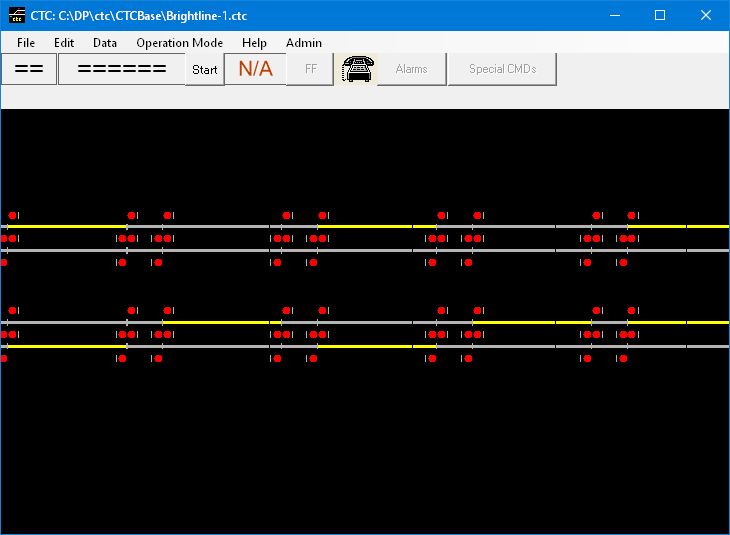For editing purpose the Detailed List panel (menu item “Edit” → “Detailed Lists” in the main panel) maintains a Selection list, where you can add or remove any objects of almost any type. If one particular object it is in your selection list, the line showing this object will be highlighted in red (please note it may be obscured by window’s selector – usually dark blue – so you may have to move the cursor or activate another window). If the same object is displayable on the main screen, it will be displayed in yellow, while others will be slightly dimmed. Note if the main window has some tools active, the display and the following description for the main window may differ. Also note, if you have a filter active, you have the option to highlight objects meeting the current filter criteria instead of those in the selection list (changing the filter criteria will not change the contents of the selection list).
The following description applies to both the detailed list and the main window (where applicable):
To add or remove one object to/from the selection list, just click the right mouse button when over the line or symbol of the object. This will toggle the membership of this object in the selection list, and the display on both panels will be updated. If you click the left mouse button, a window with detailed information for this object will be opened. You can go forth and back anytime between both windows – there is only one selection list.
Please note, that you can have objects of different types at any time in your selection list. However, which of them are actually highlighted depends on the view of the detailed list – the type of objects you’re looking at. For most views, where you list only one type of objects, e.g. switches, then only switches in your selection list are highlighted – because the list is about to display switches and nothing else. On the main window the same thing will happen – even though you may have other objects in your selection list but which are not covered by that view (though you can click on such objects in the main view, and they will be added or removed to/from the selection list, but you won’t see any evidence of that yet). You will have to change the view in the detailed list to have others highlighted instead. If you select the view “Any” in the detailed list, objects in your selection list will be highlighted, however, the main window will not highlight anything nor allow clicking to manipulate the selection list. The latter is also true if views in the detailed list are chosen that represent non-displayable objects on the main screen, including station and extern groups.
On the detailed list you also have an option to “highlight” the selected objects by not showing all others: just hit the “Selected Only” button to make it green, and you will see just the objects in your list. If you hit the button again to make it red, then all objects not in the selection list will be shown. Since the presence or absence in the selection list determines which objects are shown at all in the detailed list, the red highlight indicator is not being used.
Also on the detailed list you have the option to select all that are shown in the current view, or clear the list (will delete everything regardless of type). Furthermore, for certain object types a filter function is available, which allows you to add or remove objects to/from the selection list based on certain criteria you specify in the filter.
If group editing is available for the object types in the current view, and if you have at least one object of such a type in your selection list, you can hit the “Edit Selected” button. This will load a group edit panel, where you then can manipulate the objects passed for group editing. Note that this is a copied list and contains only objects of the appropriate type. This copy doesn’t change as long as the group edit panel is active, even if you change the contents of your selection list in the detailed list.
If you close the detailed list window, the selection list will be eliminated. For technical reason the list will be cleared if you invoke the undo or redo function within the editor.
Here is an example how it may look like if a bunch of blocks have been selected – and ready for group editing:
Highlighted blocks on the Main Screen

The same highlighted blocks in the detailed list (block view)

For group editing information go here.